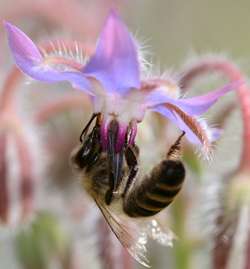Solving the mystery of the vanishing bees

(PhysOrg.com) -- As scientists continue to be baffled over the recent decline in bee populations around the world, a new model developed by Dr Andrew Barron at Macquarie University in collaboration with David Khoury and Dr Mary Myerscough at the University of Sydney, might hold some of the answers to predicting bee populations at risk.
Since 2006 the rate of honeybee colony failure has increased significantly with a report released by the UN Environment Programme last month concluding that the disastrous decline in honeybees over the last few years is unlikely to stop without a better understanding of the reasons behind the decline.
Dr Barron says “while an enormous amount is know about honeybee sociobiology, comparatively little is know about the social responses of bees to population stresses on a colony”.
In this latest study Dr Barron has discovered links between rapid population decline and chronically high forager death rates, suggesting that by examining forager numbers in a colony this new model could help predict colonies under threat.
This research also looks into one of the most mysterious aspects of colony collapse disorder (CCD), the disappearance of bees from colonies leaving abandoned brood and food stores. On this Dr Barron says: “Our model suggests that the response of bees in a stressed colony is to get outside and forage, but this just increases the stress on individual bees and makes the problem worse.”
The model also suggests strategies to rescue failing colonies. “Treatment strategies to restore failing colonies need to focus on supporting bees in the hive, and encouraging them to raise brood to boost the colony population. We’re currently testing some ideas how to do this.” said Barron.
According to the UNEP head Achim Steiner: "The way humanity manages or mismanages its nature-based assets, including pollinators, will in part define our collective future in the 21st century. The fact is that of the 100 crop species that provide 90 per cent of the world's food, over 70 are pollinated by bees.”
This research aids better understanding of the multiple threats facing bees around the world which unless addressed could lead to serious long-term consequences for food supplies. By identifying colonies at risk, this research can help scientist better understand the process of catastrophic colony failure, and how best to intervene to restore failing colonies.
Provided by Macquarie University



















